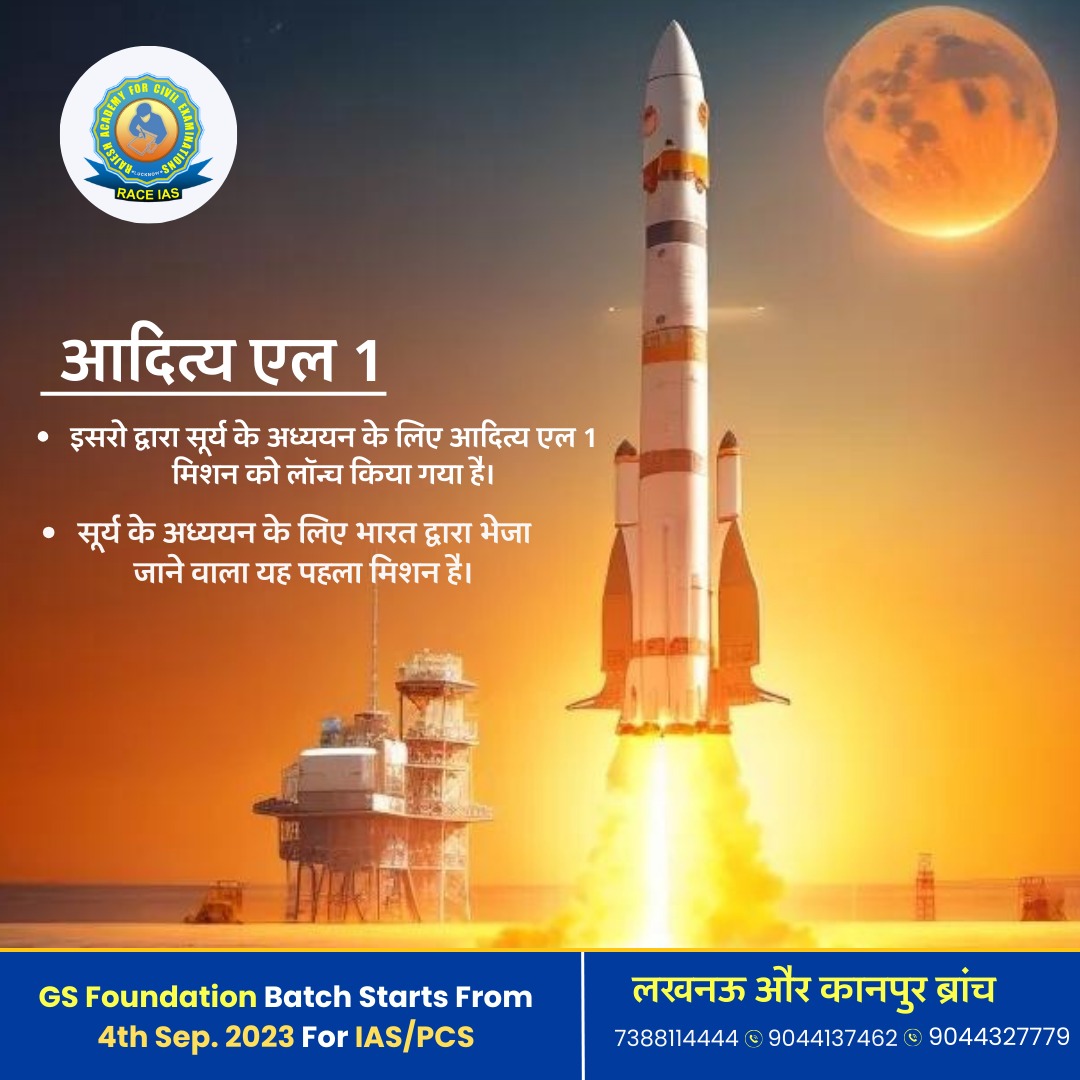
India's First Solar Mission Aditya-L1
India's First Solar Mission Aditya-L1
Launched Successfully
This topic is related to Current Affairs for IAS/PCS Prelims and Mains Exam General Studies Paper 3 Science and Technology
September 02, 2023
In News:
- ISRO successfully launched India's first solar mission Aditya L1 from Satish Dhawan Space Center in Sriharikota, Andhra Pradesh today (September 02) after Chandrayaan-3's successful moon landing.
Main points:
- Aditya L1 is carrying seven different payloads to study the Sun in detail.
- This is the country's first space mission which is related to the research of the Sun.
- This mission will study the upper atmosphere of the Sun from which important information can be gathered.
- Aditya L1 satellite has been sent 15 lakh kilometers away.
- This mission will place the satellite in L1 i.e. Lagrange Point 1.
- Aditya L1 will revolve around the Sun at this L1 point because even solar eclipse will not affect the satellite from L1 point.
- The place where this satellite will be installed will be in an area outside gravity, where neither the Sun nor the Earth will pull it towards itself.
The process from launch to in-orbit installation will have three phases:
- In the first phase, the Aditya L1 satellite will be launched by PSLV-C 57 rocket and placed in low earth orbit.
- In the second phase, the orbit of Aditya L-1 around the Earth will be gradually raised and the satellite will be taken out of the Earth's orbit.
- In the third phase, this satellite will be taken out of the Earth's gravity.
- After this, in the last step, this satellite will be placed in a large halo orbit around the L1 point.
- The work of Aditya L1 is to reach the Lagrange point after leaving the earth and in this process it will take 125 days i.e. about 4 months.
About Aditya-L1:
- Aditya-L1 spacecraft has been assembled and integrated at UR Rao Satellite Center (URSC), Bengaluru.
- The objective of this solar mission is to study the Sun's corona, Sun's photosphere, chromosphere, solar emissions, solar winds and coronal mass injection.
- Additionally, 24-hour imaging of the Sun.
- This satellite has been launched using Polar Satellite Launch Vehicle (PSLV-C 57) with 7 indigenously developed payloads.
These 7 payloads include:
Visible Emission Line Coronagraph (VELC)
- The Visible Emission Line Coronagraph (VELC) will study the dynamics of the outermost part of the Sun's atmosphere i.e. the solar corona and the most powerful explosions in the Sun i.e. coronal mass ejections.
Solar Ultraviolet Imaging Telescope (SUIT)
- The payload called the Solar Ultra-Violet Imaging Telescope (SUIT) will take near ultra-violet (UV) images of the solar photosphere and chromosphere. Along with this, SUIT will also measure changes in solar radiation near UV.
Aditya Solar Wind Particle Experiment (ASPEX)
- The Aditya Solar Wind Particle Experiment (ASPEX) and Plasma Analyzer Package for Aditya (PAPA) payloads will study the solar wind and powerful ions as well as their energy distribution.
Solar Low Energy X-ray Spectrometer (SOLEXS) and High Energy L-1 Orbiting X-ray Spectrometer (HEL-1OS)
- The Solar Low Energy X-ray Spectrometer (SoLEXS) and the High Energy L1 Orbiting X-ray Spectrometer (HEL1OS) will study X-ray rays coming from the Sun over a wide X-ray energy range.
- Whereas, the magnetometer payload is designed to measure the magnetic field between the two planets at the L1 point.
What is L1?
- L1 represents Lagrange point 1. Lagrange points 1 refer to those points in space where the gravitational forces of two space bodies (such as the Sun and the Earth) generate a field of attraction and repulsion.
- The region without gravity is called 'Lagrange Point'.
- It is named after the Italian-French mathematician Joseph-Louis Lagrange.
- According to ISRO, the Sun can be seen continuously without any shadow/eclipse from the satellite placed in 'Halo' orbit around the L-1 point.
About Polar Satellite Launch Vehicle (PSLV):
- The Polar Satellite Launch Vehicle or PSLV is a launch system operated by the Indian Space Research Organisation. India has developed it to launch its remote sensing satellite into sun synchronous orbit.
Significance:
- Aditya L-1 payload will play an important role in understanding the problem of corona heat, large-scale energy release from the corona, activities and characteristics of its light, dynamics of space weather, propagation of particles and fields etc.
----------------------------------------
Mains Exam Question
Write about the purpose and significance of India's first solar mission Aditya-L1.